
Often spotted in the landscape when they reach maturity in late summer, these big, black and yellow garden spiders and their large, circular webs are hard to miss.
But, despite their intimidating appearance, yellow garden spiders (Argiope aurantia) are good guys who deserve a home in your garden.
Let’s learn more about this beautiful spider.
What Does it Look Like?
This species is actually quite beautiful if you care to look close enough.
Its scientific Latin name translates to “gilded silver-face” (the genus name meaning “silver-face”, while the specific epithet aurantia means “gilded”).
The spider can also be found along the eaves of houses and outbuildings or in any tall vegetation where they can securely stretch a web. Female Argiope aurantia spiders tend to be somewhat local, often staying in one place throughout much of their lifetime. The web of the yellow garden spider is distinctive: a circular shape up to 2 feet (60 cm) in diameter, with a dense zigzag of silk, known as a stabilimentum, in the center.
The large females have a distinctive black and yellow abdomen, and 8 black legs that are graced with red or yellow markings.
The male garden spider isn’t quite as fancy or as large. He’s brown and drab and only about a quarter of the size of the female. A female garden spider spins a unique web, too.
Her large, distinctive web is built in mid-summer when she’s hoping to secure a mate and trap enough food to support her egg-laying efforts.
You’ll find the females’ webs stretched between the tomato stakes in your vegetable garden. The female spider is almost always waiting for prey at the center of the web, near the stabilimentum. Males build webs, too, though theirs are far smaller. Often located near, or even within, the female’s web, the male’s web is denser and not nearly as “fancy.”
Many times there are several male webs found near each female web, which can lead to some interesting mating behavior.
Where Do They Live?
They’re found in each of the 48 contiguous states and even in Hawaii.
Their range also extends southward into Central America and northward into the southern regions of Canada. Gardens are great homes for the garden spider.
Females prefer to position their web in a protected site that is sheltered from heavy winds.
How Do They Multiply?
Male garden spiders visit females to breed in mid to late summer.
In an interesting courtship ritual, the male garden spider plucks the strings of the female’s web gently and in a very specific way, to make her aware of his presence. Then he slowly approaches and hopes he doesn’t get attacked in the process.
During mating, the male garden spider leaves his palps (the place where he stores his sperm) behind as “plugs” to prevent other males from mating with the same female garden spider.
Then, as soon as mating ends, the male spontaneously dies, often while he’s still attached to the female. Occasionally the female spider will consume the male’s body after mating.
The egg cases are positioned on the web, typically near the center. The female garden spider protects her egg cases until her death, around the time of the first frost.
Come spring, the eggs hatch, and dust-like spiderlings emerge to find a new home in the garden. They’re often carried around the landscape on the wind. If you’re picturing ‘Charlotte’s Web’ it’s a lot like that.
What Do They Eat?
It consumes lots of common landscape pests, as well as bees, moths, beetles, wasps, and just about any other flying insect that gets trapped in its web. There are, of course, many other species of spiders worth appreciating in your garden. They’re extremely valuable predators who help manage pests in some surprising ways.
Instead, they crawl around and hunt for their prey. These spiders are known as cursorial, or hunting, spiders. Cursorial spiders, such as jumping spiders, wolf spiders, and crab spiders, are especially important to gardeners because they move around the garden to find their prey. Numerous studies have shown that spiders consume a massive amount of garden pests, including aphids, mites, asparagus beetles, squash bugs, budworms, caterpillars, and many more.
Are They Aggressive?
These spiders may bite if disturbed or harassed, but the venom is harmless to non-allergic humans, roughly equivalent to a bumblebee sting in intensity.
They can bite if threatened, trapped, or stepped on. Their bite is said to feel much like a bee sting and causes redness and swelling at the bite site. Like all spiders, yellow garden spiders are not “out to get you,” nor will they purposefully attack or harm humans.
Of the 3000 or so species of spiders found in North America, only four are considered harmful to humans. They are the black widow, the brown recluse, the hobo spider (found in the arid climate of western states), and the yellow sac, which is thought to be the most common source of nuisance bites across the continent.
Having Issues With Spiders?
Drive Bye Exterminators are here for you. Contact us now for a free inspection and quote for removal.






